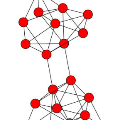Network embedding has emerged as a promising research field for network analysis. Recently, an approach, named Barlow Twins, has been proposed for self-supervised learning in computer vision by applying the redundancy-reduction principle to the embedding vectors corresponding to two distorted versions of the image samples. Motivated by this, we propose Barlow Graph Auto-Encoder, a simple yet effective architecture for learning network embedding. It aims to maximize the similarity between the embedding vectors of immediate and larger neighborhoods of a node, while minimizing the redundancy between the components of these projections. In addition, we also present the variation counterpart named as Barlow Variational Graph Auto-Encoder. Our approach yields promising results for inductive link prediction and is also on par with state of the art for clustering and downstream node classification, as demonstrated by extensive comparisons with several well-known techniques on three benchmark citation datasets.
翻译:网络嵌入已成为一个有希望的网络分析研究领域。最近,有人提议采用名为Barlow Twins的方法,通过对两个扭曲图像样本的嵌入矢量应用冗余减少原则,在计算机愿景中进行自我监督学习。为此,我们提议采用Barlow Graph Auto-Encoder,这是学习网络嵌入的一个简单而有效的架构,目的是最大限度地扩大节点附近和大邻的嵌入矢量之间的相似性,同时尽量减少这些预测各组成部分之间的冗余。此外,我们还介绍了名为Barlow Variational Graphation Auto-Encolder的变异对应方。我们的方法为感化链接预测带来了有希望的结果,也与组合和下游节点分类的艺术状况相当,这体现在与三个基准引用数据集上的若干著名技术的广泛比较。




